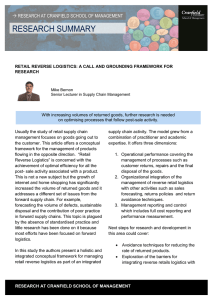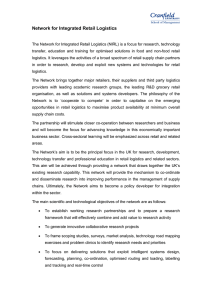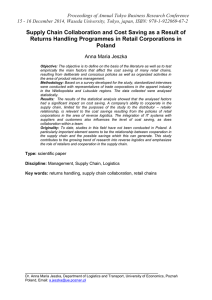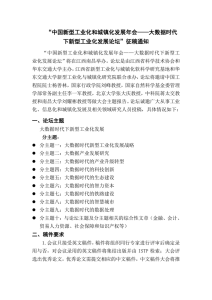Document 14833814
advertisement
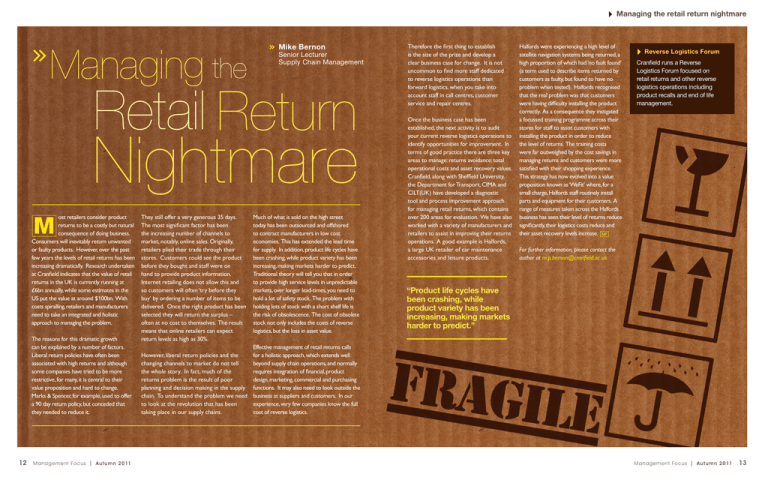
Managing the retail return nightmare Managing the Mike Bernon Senior Lecturer Supply Chain Management Retail Return Nightmare M ost retailers consider product returns to be a costly but natural consequence of doing business. Consumers will inevitably return unwanted or faulty products. However, over the past few years the levels of retail returns has been increasing dramatically. Research undertaken at Cranfield indicates that the value of retail returns in the UK is currently running at £6bn annually, while some estimates in the US put the value at around $100bn. With costs spiralling, retailers and manufacturers need to take an integrated and holistic approach to managing the problem. The reasons for this dramatic growth can be explained by a number of factors. Liberal return policies have often been associated with high returns and although some companies have tried to be more restrictive, for many, it is central to their value proposition and hard to change. Marks & Spencer, for example, used to offer a 90 day return policy, but conceded that they needed to reduce it. 12 Management Focus | Autumn 2011 They still offer a very generous 35 days. The most significant factor has been the increasing number of channels to market, notably, online sales. Originally, retailers plied their trade through their stores. Customers could see the product before they bought and staff were on hand to provide product information. Internet retailing does not allow this and so customers will often ‘try before they buy’ by ordering a number of items to be delivered. Once the right product has been selected they will return the surplus – often at no cost to themselves. The result means that online retailers can expect return levels as high as 30%. However, liberal return policies and the changing channels to market do not tell the whole story. In fact, much of the returns problem is the result of poor planning and decision making in the supply chain. To understand the problem we need to look at the revolution that has been taking place in our supply chains. Much of what is sold on the high street today has been outsourced and offshored to contract manufacturers in low cost economies. This has extended the lead time for supply. In addition, product life cycles have been crashing, while product variety has been increasing, making markets harder to predict. Traditional theory will tell you that in order to provide high service levels in unpredictable markets, over longer lead-times, you need to hold a lot of safety stock. The problem with holding lots of stock with a short shelf life is the risk of obsolescence. The cost of obsolete stock not only includes the costs of reverse logistics, but the loss in asset value. Therefore the first thing to establish is the size of the prize and develop a clear business case for change. It is not uncommon to find more staff dedicated to reverse logistics operations than forward logistics, when you take into account staff in call centres, customer service and repair centres. Once the business case has been established, the next activity is to audit your current reverse logistics operations to identify opportunities for improvement. In terms of good practice there are three key areas to manage: returns avoidance; total operational costs and asset recovery values. Cranfield, along with Sheffield University, the Department for Transport, CIMA and CILT(UK) have developed a diagnostic tool and process improvement approach for managing retail returns, which contains over 200 areas for evaluation. We have also worked with a variety of manufacturers and retailers to assist in improving their returns operations. A good example is Halfords, a large UK retailer of car maintenance accessories and leisure products. Halfords were experiencing a high level of satellite navigation systems being returned, a high proportion of which had ‘no fault found’ (a term used to describe items returned by customers as faulty, but found to have no problem when tested). Halfords recognised that the real problem was that customers were having difficulty installing the product correctly. As a consequence they instigated a focussed training programme across their stores for staff to assist customers with installing the product in order to reduce the level of returns. The training costs were far outweighed by the cost savings in managing returns and customers were more satisfied with their shopping experience. This strategy has now evolved into a value proposition known as ‘WeFit’ where, for a small charge, Halfords staff routinely install parts and equipment for their customers. A range of measures taken across the Halfords business has seen their level of returns reduce significantly, their logistics costs reduce and their asset recovery levels increase. MF Reverse Logistics Forum Cranfield runs a Reverse Logistics Forum focused on retail returns and other reverse logistics operations including product recalls and end of life management. For further information, please contact the author at m.p.bernon@cranfield.ac.uk “Product life cycles have been crashing, while product variety has been increasing, making markets harder to predict.” Effective management of retail returns calls for a holistic approach, which extends well beyond supply chain operations, and normally requires integration of financial, product design, marketing, commercial and purchasing functions. It may also need to look outside the business at suppliers and customers. In our experience, very few companies know the full cost of reverse logistics. Management Focus | Autumn 2011 13
